Link
In this class we expand on Art Class 104 talking about the process of creating a painting in layers: compositional layout, background, foreground and details. Because painting is two-dimensional we want to create the illusion of three-dimensions and we do this by painting in reverse. We also talk about how color holds meaning and it is important for you to consider what you want to communicate through color in your own painting.
Materials Needed:
Primary Colors and white (hot and cold primaries preferably), acrylic, poster paint or watercolor
painting that you started yesterday
a range of brushes
water
palette
Apron (or an old shirt)
wet cloth (or scrap newspaper)
0 notes
Link
In this class we will begin the process of creating an abstract painting composition. Please refer to the visual resources on this blog of artists who have employed color theory principles to develop paintings and refer back to your own experiments that you have done as part of this course. You might have discovered when creating your painting palettes that you were drawn to particular colors and tones. Apply your palette choices to your painting as this is what we call artistic research and I discuss this in the video.
Materials Needed:
Yellow paint (acrylic, watercolor or poster paint)
One piece of paper folded into six equal rectangles
One piece of paper for the painting composition
A fine brush
Palette
Water
Apron (or old t-shirt)
Wet cloth (or scrap newspaper)
0 notes
Link
In this class we discuss complimentary pairs and the secret of making black. At the end of the short video Carron gives a demonstration on creating tone gradation painting experiments.
Materials Needed:
Primary colors: red, blue, and yellow (or hot and cold primary colors outlined in Art Class 101)
One sheet of paper cut into thirds (each strip needs to be folded into eight sections)
A range of brushes
Water
Palette
Wet cloth (or scrap newspaper to keep the area clean)
apron (or an old t-shirt something we can get messy in)
0 notes
Link
In the second, Color Theory 102, we will discuss secondary and tertiary colors. I will also share some painting techniques and we will recap on how to set-up for painting. Get ready before class and paint along with me. Learn how to mix the secondary colors and then invent your own tertiary colors in an independent task after the video is over. This exercise is suitable for ages 8 to 14 or anyone who wants to learn the basic principles of color theory. For advanced learners, I hope you are able to distinguish how the hot and cold primary colors work when mixed to create secondary colors.
Materials needed for Art Class 102 & things you can find from around your home:
Paint - the primary colors in poster paint, water color or acrylic paint
A palette - an old dinning plate, a paper plate, or piece of cardboard
A water container - an old mug that nobody wants or a class jar for water (It's important that this has weight to it so not a paper cup or polystyrene cup as this will create an accident!)
Brushes (a range of brushes, fine, round and square or whatever you have lying around your home)
Paper - two sheets any color, (this could be sugar paper or cartridge paper)
A wet cloth or old newspaper to cover your painting area (we like to get messy so let's make an area where we can get creative and other people who we share the space with won't get angry with us!)
0 notes
Link
In today's art class we will discuss how there are six primary colors and learn about the hot and cold primary colors. This video is for art learners age 8 to 14, for art teachers to use as a resource for their classes and parents or guardians looking for fun creative activities for their children to do while living in quarantine life.
Here I demonstrate how to set up your area ready for painting, introduce the six primary color theory and then set an exercise where you get to experiment with color mixing. Color mixing is super fun! In this short course on color theory you will learn the fundamental principles, learn by doing and making and create your own artwork inspired by your experimentation at the start of the course.
Materials needed for Art Class 101 & things you can find from around your home:
Paint - the primary colors in poster paint, water color or acrylic paint
A palette - an old dinning plate, a paper plate, or piece of cardboard
A water container - an old mug that nobody wants or a class jar for water (It's important that this has weight to it so not a paper cup or polystyrene cup as this will create an accident!)
Brushes (a range of brushes, fine, round and square or whatever you have lying around your home)
Paper - two sheets any color, (this could be sugar paper or cartridge paper)
A wet cloth or old newspaper to cover your painting area (we like to get messy so let's make an area where we can get creative and other people who we share the space with won't get angry with us!)
For this class it's about having access to the primary colors but if you also have Cadmium Red, Alizarin Crimson, Cadmium Yellow, Lemon Yellow, Ultramarine Blue and Phthalo Blue you can expand your color mixing knowledge. These can also be purchased through Blick or Golden, while you are shopping I would also get some white and black acrylic paint and a sketchbook or a pack of sugar paper: https://www.dickblick.com
Carron's Teaching Philosophy:
I am a qualified Art Teacher and in this short course I teach art to expand creative thinking skills. This is not about copying a technique as in most instructional videos, this is about expanding your creativity through discovery and experimentation. In Week 1 the first three classes will focus on learning the basic principles of color theory and painting techniques. In the last two classes I will walk you through the process of creating your own painting composition inspired by your painting experiments in the first two classes.
Here is the Schedule of the Short Course in Color Theory:
Art Class 101: Six Primary Color Theory
Art Class 102: Secondary and Tertiary Colors
Art Class 103: Complimentary Colors and Tone Gradation
Art Class 104: Creating a painting composition
Art Class 105: Finishing your own composition
A few more things before we get started: Please consider contributing your final painting composition to the online digital exhibition, becoming part of a creative learning community. Take a photo and email it to [email protected] and the first ten images will be edited into the video and everyone will be exhibited on the blog at: artclassfundamentals.tumblr.com
In Art we learn by doing and making. In this series of instructional videos I will teach and demonstrate a new principle and set a task for you to experiment with each day. Each task will take each art learner 30mins to one hour to work on independently. I recommend you set up your painting area before you start the video. A demonstration of how to set-up is described in Art Class 101. The classes are organized in courses of week blocks. In each course you will discover an artistic technique and then create your own artwork inspired by your artistic research.
0 notes
Link
In this last class of the short course on Color Theory with Carron, she introduces the importance of artistic research and demonstrates some funky painting techniques. When we want to create the illusion of depth within a painting we can do this by thinking about painting as a process of layers. In this example demonstration Carron outlines the method of painting the background, the foreground and then details.
Once you’ve completed your final compositions please take a photo and email it to [email protected] and your work will become part of an online digital exhibition. Let’s share what we learn together!
0 notes
Photo
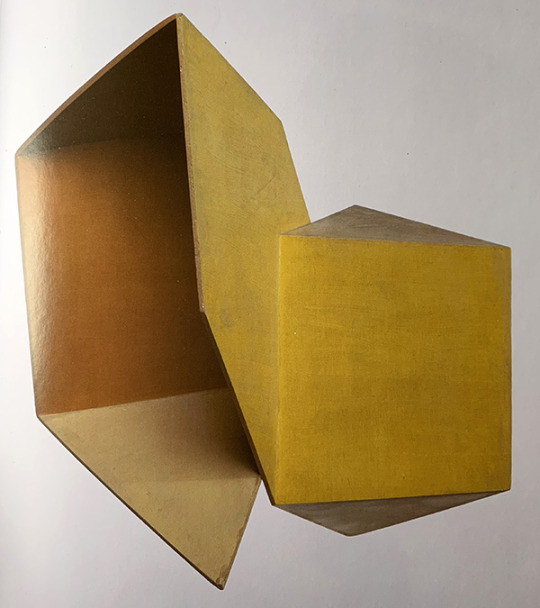

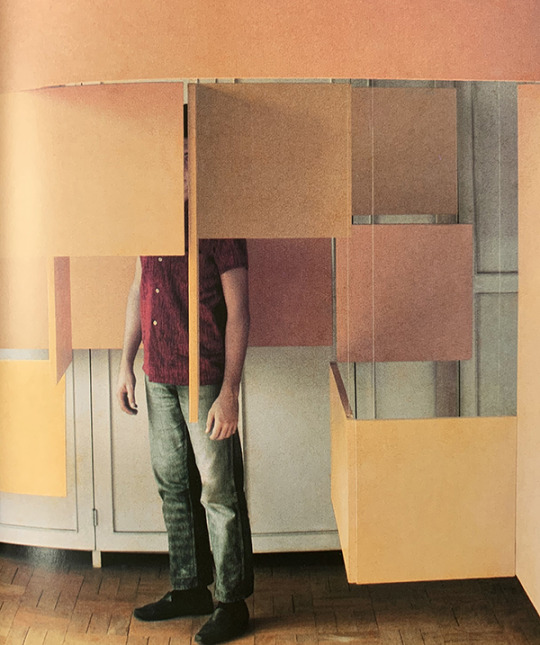
Visual Art Resources for Art Class 104:
Now we are jumping into our travel machine going forward in time to Brazil to look at the artist Helio Oiticicia who was part of the Concrete Art Movement in the post-war period. In the first image he has created a three-dimensional painting that are exhibited in Museums and Galleries suspended in space form the ceiling so they really engage with the movement of the viewer. In the videos we talk about how color can impact our mood and in these installations thinking about color fields Helio is taking use on a journey to explore the subtleties and how it can impact our bodies. In the model for the installations what primary colors has he used to create his palettes for each room? How will you be inspired by these principles as you create your own composition?
0 notes
Photo

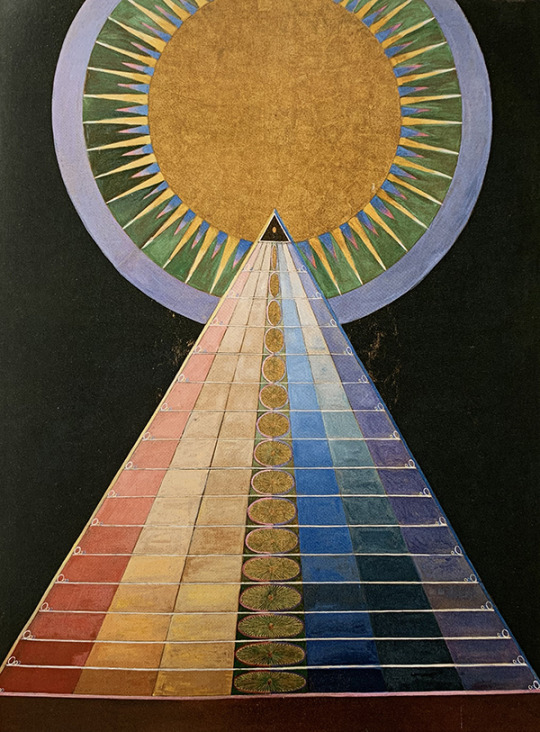
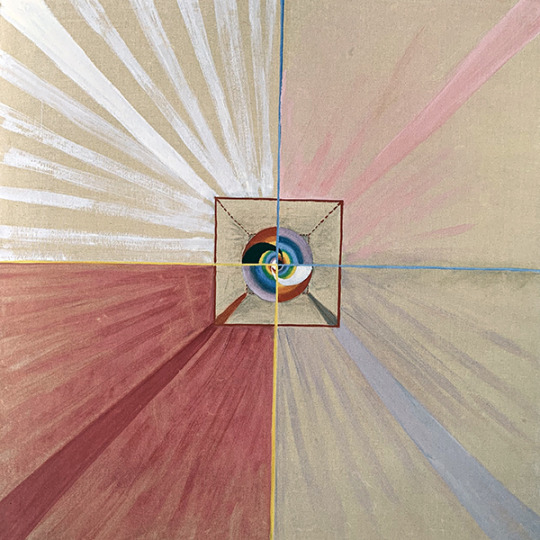

Visual Art Resources for Art Class 104 continued:
Hilma af Klint is a wonderful example of an artist who employed a deep understanding of color theory principles to amass to create a large body of work. She first established herself as a painter painting landscapes and still lives in the late nineteenth century in Sweden. Latterly she after working with a group of women to mine her subconscious realm through seances and drawing exercises she began working on these abstract works that she wanted to be exhibited in a temple built in the form of a spiral. In the top left painting you can see how she has used the line of the spiral to create a mirror image of symmetry as a compositional strategy. Even in painting the line of the spiral she alters color and tone to accentuate movement. She begins with the two teritary colors of brown and grey in mirror effect and contrasts this with the use of the rainbow colors at the base of the circular form. The rainbow colors are also mirrored employing tone gradation to add a three-dimensional plane in the composition. Explore how Hilma has used color theory principles in the other three paintings? Look at how she has employed abstract shape to build her compositions. How might you be inspired by these forms to create your own compositions?
0 notes
Photo
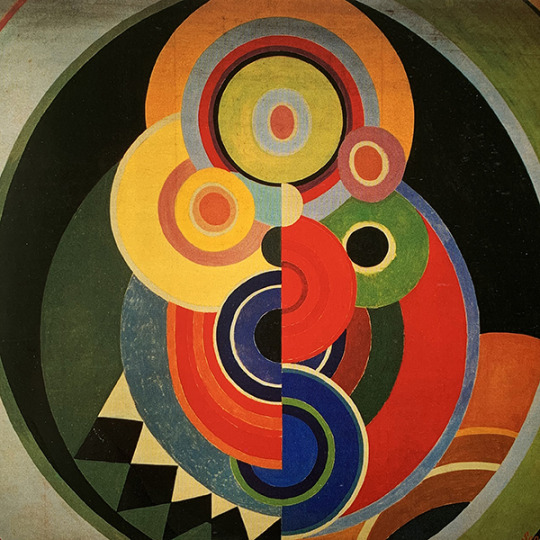
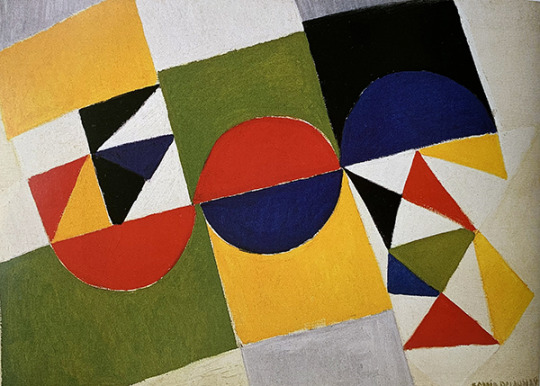
Visual Art Resources for Art Class 104 continued:
The next artist we are going to look at for inspiration is Sonia Delauney who was born in the Ukraine and moved to St. Petersburg, Russia at the age of 5 to live with her uncle who could pay for a formal education. In 1905 she decided to move to Paris so she could study at an art academy. Note, this was at a time when women were just beginning to enter the art academies across Europe, up until now fine art training was only given to men. Sonia Delauney is known for her painting and textile compositions and made a living in her early days in fashion owning a boutique in Paris up until the depression. In the top painting you can see the color wheel employed as an integral part of the compositional layout to explore different complimentary colors. The form of the spiral and the intersecting colors create a sense of movement in the work. In the second piece how is she employing complimentary pairs to guide our eyes around the work? How is she using symmetry to design the composition?
0 notes
Photo
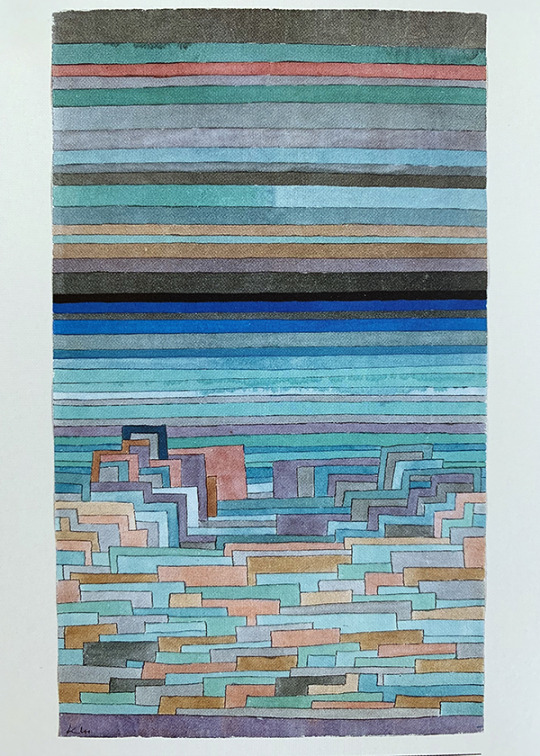

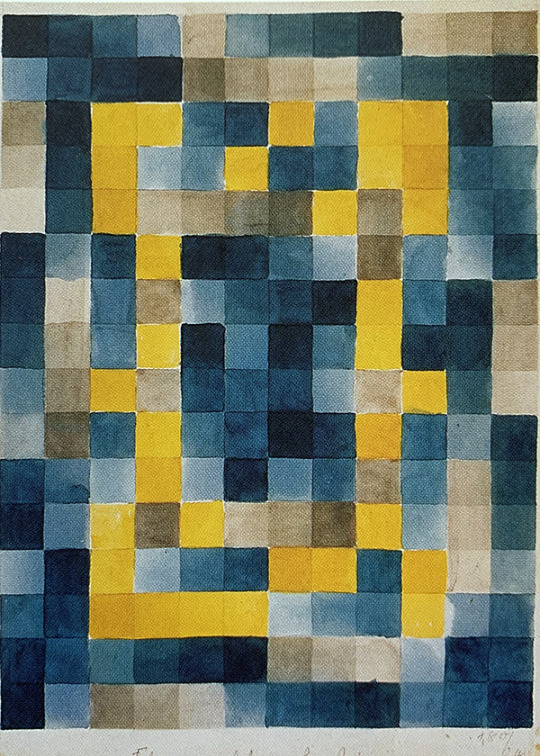
Visual Resources for Art Class 104 continued:
In the first two compositions by Paul Klee he has used the abstract shapes of lines and rectangles to create these dynamic compositions where he can investigate color. In the last painting by Walter Gropius he has created a color experiment using the abstract shape of a square that become the design for a carpet. In the first painting by Klee how is he using color to create movement in the painting? What color mixing principles is he applying in the painting?
1 note
·
View note
Photo
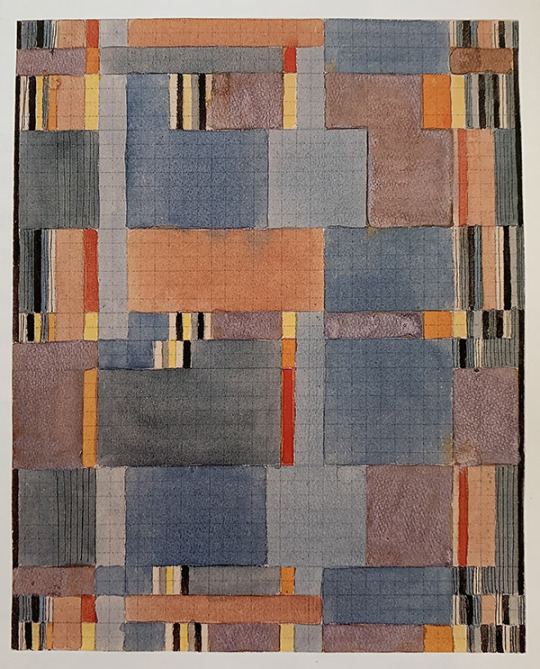
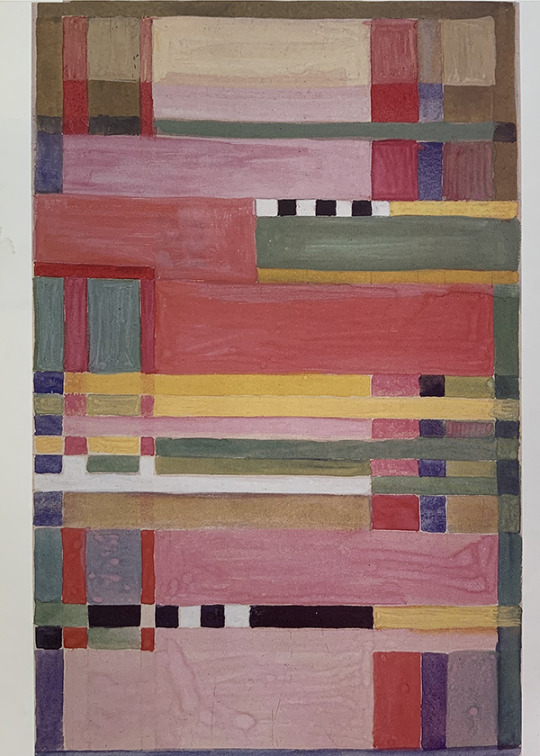

Visual Art Resources continued:
Then let’s travel to Germany to the Bauhaus Art School in 1919. The Bauhaus was a pioneer of what we call modernist design. The three watercolor and gouache paintings above by Gunta Stolzl are preliminary designs for weavings. Gunta Stolzl entered the school as a student in 1919 and was the only female to become a ‘master artist’ by the time of her departure in 1931, two years before the school closed due to the rise of Facism in Germany. In analysis of her designs how is she using complimentary pairs to create the composition? How do you think she is mixing color to create different tones?
2 notes
·
View notes
Photo

Visual Resources for Creating a Painting Composition
In our travel machine we can travel around the world from our dinning room table to study different cultures and their art. Let’s travel to Ghana, in Africa first that has a long history of abstract design in textiles and their artifacts. The image (top left) is a piece of Asante Textile weaving. Rectangular and zig-zag shapes charaterize Asante abstract textile design. How are they using shape to make a dynamic design? How are they using complimentary colors to create rhythm?
0 notes
Link
In this short class, Carron will demonstrate the process of thinking and making a painting composition inspired by the color theory principles learnt in classes 101 to 103. The task today will be to create six thumbnail sketches thinking about what you want to communicate with color. Select one compositional idea to enlarge onto your paper or canvas.
0 notes
Photo

Complimentary Pairs
In one row I have the primary colors and in the second row I have placed the secondary colors. For instance red and green are a complimentary pair because the primary color of red doesn’t make green. Can you figure out the other complimentary pairs and explain why they are pairs? It will also be clearer after watching the video Color Theory 103.
0 notes
Link
In this art class we will learn how to make black and learn the complimentary pairs. Carron will demonstrate the exercise for today which is to experiment with mixing complimentary pairs to create different tones of color. Cut one sheet of paper into three strips and fold it into eight segments ready for this exercise. Tomorrow we will be looking at artists and creating our own compositions.
0 notes
Text
A little note to Art Learners
from Carron Little
Dear Art Learner,
As you have probably gathered I’m not going to dictate what you do in these Art Classes, as these videos are about planting seeds for you to discover and invent mixing colors yourself. The way I teach art is about you experimenting and discovering because in art we learn by doing and making. In each video I will introduce an exercise and in this series on Color Theory it is about experimenting with mixing colors and learning painting techniques. After the first three classes looking at color theory principles we will then look at some artists who have used color theory principles to develop painting compositions. I will then walk you through a variety of approaches you could take to creating your own painting composition. In the last two classes for this week the time will be dedicated to you creating your own composition for an online exhibition. This is all about having fun, learning some new skills and being creative in a time of quarantine!
In creativity, yours Carron
0 notes
Photo
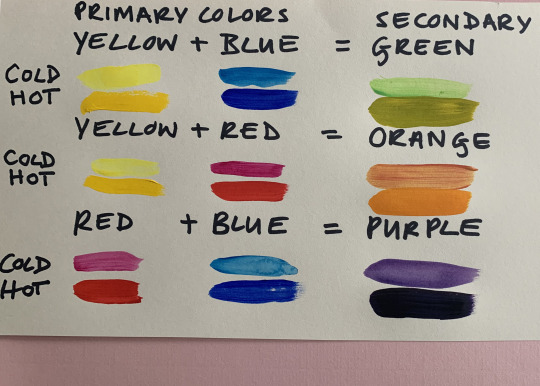
Here is a sample chart of what primary colors you can mix together to create a secondary color. In Art Class 101 I hope you discovered how you could make these colors by experimenting on your own and mixing interesting colors. What did you discover? Feel free to email me your results at [email protected] and I will load up a digital exhibition of your work.
0 notes